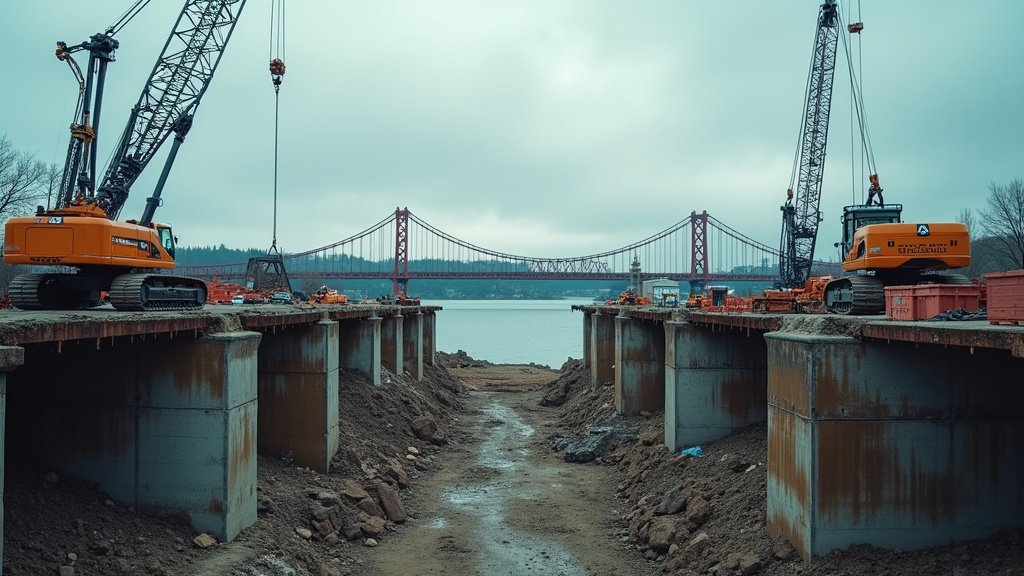The City of Portland will close a Northeast Portland bridge for two years to facilitate its replacement with a structure designed to withstand earthquakes. The project, scheduled to begin soon, will require the bridge to be temporarily closed to ensure construction can proceed safely and efficiently. The new bridge will be built to the latest seismic standards, increasing the safety and reliability of the city’s infrastructure. Residents are advised to plan for traffic disruptions and use alternate routes during the construction period.
Project Overview
The Northeast Portland bridge replacement project is a critical undertaking aimed at bolstering the city’s infrastructure against seismic events. The existing bridge, located in the city’s Northeast quadrant, will be replaced with a modern structure engineered to meet current seismic resilience standards. This proactive measure is intended to protect the city’s transportation network and ensure public safety in the event of an earthquake. The comprehensive rebuild is planned to be executed within a two-year timeframe.
Construction Details and Seismic Standards
The new bridge will be constructed to the most recent engineering standards for seismic resistance. These standards include considerations for ground motion, soil conditions, and structural design to minimize damage and maintain functionality during and after an earthquake. The construction process will involve demolition of the existing bridge and the subsequent erection of the new structure. This will involve specialized equipment and construction techniques to ensure the bridge’s longevity and resistance to environmental stressors.
Traffic and Community Impact
The closure of the Northeast Portland bridge will inevitably cause traffic disruptions in the surrounding area. The city is actively advising residents and commuters to anticipate these disruptions and plan alternate routes during the construction period. Public awareness campaigns and traffic management strategies will be implemented to mitigate the impact of the closure. These may include clearly marked detour routes, real-time traffic updates, and public transportation enhancements to help minimize delays and congestion.
Planning and Preparation
The City of Portland has likely undertaken extensive planning and preparation for this significant infrastructure project. This would include environmental impact assessments, engineering studies, and community consultations. The planning phase is crucial for optimizing the project’s design, minimizing environmental effects, and addressing community concerns. The city’s planning efforts likely involve coordination with various stakeholders, including transportation agencies, emergency services, and community representatives.
Benefits of the Replacement
The primary benefit of the bridge replacement is the enhanced safety and reliability of the city’s infrastructure. A bridge designed to meet modern seismic standards is crucial for ensuring that essential transportation routes remain operational during and after an earthquake. This resilience is vital for emergency response, the movement of goods and services, and the overall economic stability of the region. The improved design and materials of the new bridge will also likely extend its lifespan and reduce long-term maintenance costs.
Seismic Considerations
Portland, like much of the Pacific Northwest, is located in a seismically active zone. The Cascadia Subduction Zone, a major source of potential earthquakes, poses a significant threat to the region. Recognizing this risk, the city is taking proactive steps to strengthen its infrastructure. This is part of a broader strategy to increase community resilience and reduce potential damage and disruption from a major seismic event. The new bridge is one component of a comprehensive strategy for disaster preparedness.
Economic Implications
The bridge replacement project is expected to have economic implications, both positive and negative. While the closure will likely disrupt traffic and potentially affect local businesses, the project will also create construction jobs and stimulate economic activity. The long-term benefits of a resilient infrastructure include reduced costs from damage and repairs after an earthquake and improved economic productivity due to uninterrupted transportation.
Environmental Considerations
Environmental considerations are usually an integral part of infrastructure projects of this scale. These may include measures to minimize the impact on local ecosystems, reduce construction-related pollution, and manage waste effectively. The project might incorporate sustainable design principles and the use of environmentally friendly materials to minimize its environmental footprint. Environmental assessments will be a crucial component of project management.
Public Communication
Effective public communication will be critical to the success of this project. The city will likely provide regular updates to the public about the project’s progress, including construction schedules, traffic alerts, and community outreach events. This will help keep the public informed, address concerns, and build support for the project. Clear communication will contribute to minimizing community disruption and maintaining public trust.
Long-Term Sustainability
The design and construction of the new bridge will likely consider long-term sustainability. This could include incorporating durable materials that require minimal maintenance, optimizing energy efficiency, and integrating features to enhance the bridge’s resilience to climate change impacts. Long-term sustainability considerations ensure that the infrastructure remains functional and cost-effective over its lifespan.
Conclusion
The City of Portland’s decision to replace the Northeast Portland bridge underscores a commitment to public safety and infrastructure resilience. This project is a critical investment in the city’s future, ensuring that its transportation network can withstand the challenges of a seismically active environment. The temporary closure and construction will require patience and planning from residents, but the long-term benefits of a stronger, more reliable bridge will be significant.



